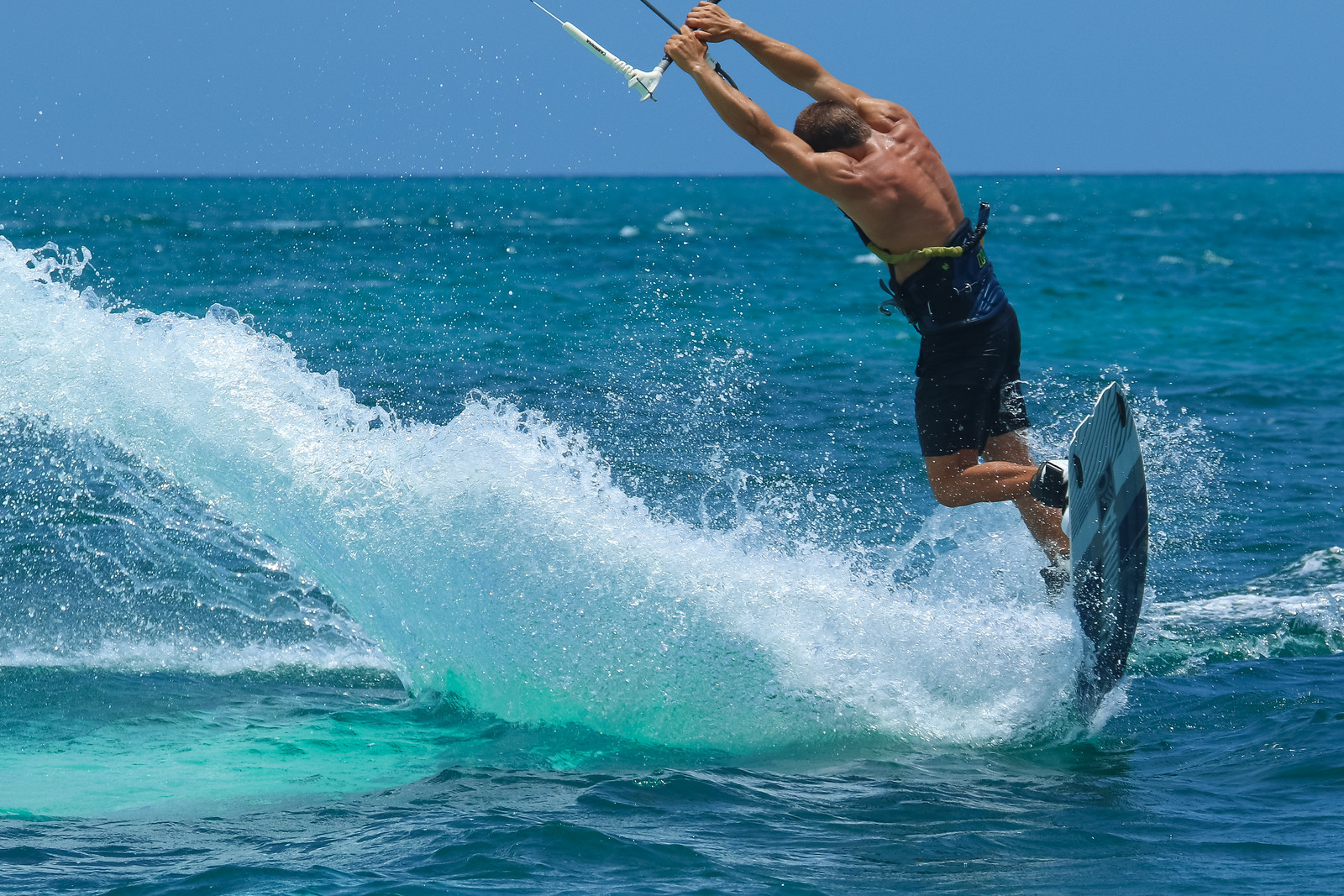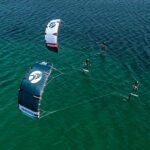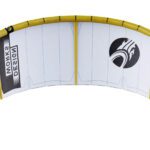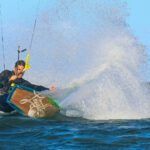
Jumps and tricks in kitesurfing: How do I perform jumps and tricks in kitesurfing?
Introduction.
- Briefly introduce the topic of jumps and tricks in kitesurfing.
- Highlight the popularity of kitesurfing as an extreme water sport.
- Mention the excitement and thrill of performing jumps and tricks in kitesurfing.
Basics of Kitesurfing.
- Provide an overview of kitesurfing as a water sport.
- Explain the equipment used in kitesurfing, including the kite, board, and control bar.
- Discuss the importance of wind conditions and safety measures in kitesurfing.
Importance of Jumps and Tricks in Kitesurfing.
- Highlight the role of jumps and tricks in adding excitement and challenge to kitesurfing.
- Discuss how jumps and tricks can enhance the overall experience of kitesurfing.
- Mention the different jumps and tricks that can be performed in kitesurfing.
Learning to Perform Jumps and Tricks.
- Discuss the importance of proper training and instruction for learning jumps and tricks in kitesurfing.
- Provide step-by-step guidance on basic jumps and tricks, including body positioning, kite control, and landing techniques.
- Emphasize the need for practice, patience, and safety precautions while learning jumps and tricks in kitesurfing.
Advanced Jumps and Tricks.
- Discuss advanced jumps and tricks that experienced kitesurfers can perform.
- Highlight the challenges and risks associated with advanced jumps and tricks.
- Provide tips and techniques for mastering advanced jumps and tricks in kitesurfing.
Safety Measures for Jumps and Tricks.
- Emphasize the importance of safety in kitesurfing, especially when performing jumps and tricks.
- Discuss using safety gear, such as helmets, impact vests, and harnesses.
- Provide guidelines for assessing wind conditions, choosing appropriate spots for jumps and tricks, and avoiding potential hazards.
Tips for Perfecting Jumps and Tricks.
- Provide additional tips and techniques for improving jumps and tricks in kitesurfing.
- Discuss the importance of body positioning, timing, and control in achieving perfect jumps and tricks.
- Mention the benefits of practicing with experienced kitesurfers and seeking feedback for improvement.
Common Mistakes to Avoid.
- Discuss common mistakes that beginners make while attempting jumps and tricks in kitesurfing.
- Guide how to avoid these mistakes and improve performance.
- Highlight the risks and consequences of making mistakes during jumps and tricks in kitesurfing.
- Summarize the key points covered in the article.
- Highlight the importance of safety, practice, and perseverance in mastering jumps and tricks in kitesurfing.
- Encourage readers to follow proper training and safety measures for a safe and enjoyable kitesurfing experience.
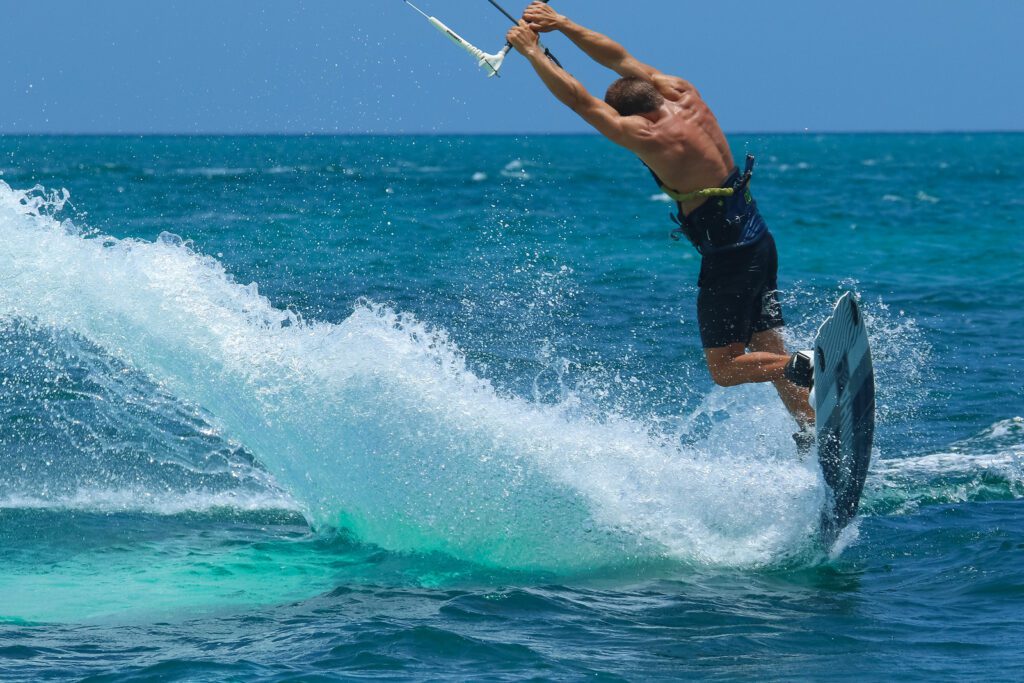
Article.
Jumps and Tricks in Kitesurfing: How Do I Perform Jumps and Tricks in Kitesurfing?
Kitesurfing, also known as kiteboarding, is a thrilling and extreme water sport combining windsurfing, surfing, and wakeboarding elements. One of the most exciting aspects of kitesurfing is the ability to perform.
How Do I Perform Jumps and Tricks in Kitesurfing?
Kitesurfing, also known as kiteboarding, is a thrilling and extreme water sport combining windsurfing, surfing, and wakeboarding elements. One of the most exciting aspects of kitesurfing is the ability to perform jumps and tricks, adding excitement and challenge to the sport. If you’re interested in learning how to perform jumps and tricks in kitesurfing, this article will provide you with a comprehensive guide to getting started.
Basics of Kitesurfing.
Before diving into jumps and tricks, it’s essential to understand the basics of kitesurfing. Kitesurfing involves riding a board while being propelled by a kite controlled by a control bar. The rider stands on the board and uses the kite to catch the wind and generate power, allowing them to glide across the water’s surface. It requires reasonable control of the kite, body positioning, and coordination to safely maneuver the board and perform jumps and tricks.
Importance of Jumps and Tricks in Kitesurfing.
Jumps and tricks are an essential part of kitesurfing for many riders. They add excitement, challenge, and creativity to the sport, allowing riders to push their limits and express their style. Whether you’re a beginner or an experienced kitesurfer, learning and mastering jumps and tricks can significantly enhance your overall kitesurfing experience.
Learning to Perform Jumps and Tricks.
Performing jumps and tricks in kitesurfing requires proper training, practice, and safety precautions. Here are the steps to get started:
- Learn the basics: Before attempting jumps and tricks, it’s crucial to have a solid foundation in kitesurfing. This includes mastering kite control, body positioning, and board control. Take lessons from a certified instructor to learn the basics properly and gain confidence in handling the kite and the board.
- Start with basic jumps: Once you have a good grasp of the basics, you can start practicing basic jumps. This includes simple jumps like the ollie, which involves jumping off the water and landing back on the board. Practice jumping with control and smooth landings to build your skills and confidence.
- Progress to tricks: You can learn tricks once you’re comfortable with basic jumps. Schemes in kitesurfing are often named after similar tricks in other board sports like skateboarding or snowboarding, such as grabs, spins, and flips. Start with simple tricks and gradually progress to more advanced ones as you gain confidence and skills.
- Focus on technique: Technique plays a crucial role in performing jumps and tricks successfully. Pay attention to your body positioning, kite control, and timing to execute maneuvers smoothly. Practice regularly and seek feedback from experienced riders to improve your technique and progress to more complex tricks.
- Safety first: Safety is paramount in kitesurfing, especially when performing jumps and tricks. Always wear appropriate safety gear, including a helmet, impact vest, and harness. Assess the wind conditions before attempting jumps and tricks, and choose the right spots with enough space and no obstacles. Practice in safe conditions and never take unnecessary risks.
Advanced Jumps and Tricks.
As you gain experience and confidence in kitesurfing, you should progress to more advanced jumps and tricks. These tricks require more skill, control, and risk management. Here are some famous advanced jumps and tricks in kitesurfing:
- Handle passes: Handle passes are tricks where the rider passes the control bar behind their back or around their body while performing jumps or spins. This adds extra difficulty and style to your jumps and tricks. There are various handle pass tricks, such as the front loop handle pass, back loop handle pass, and kite loop handle pass. To execute smoothly and safely, these tricks require reasonable kite control, body positioning, and timing.
- Board-offs are tricks where the rider removes their feet from the board while in the air and catches it. This adds a unique and challenging element to your jumps and tricks. Board-offs can be done in different variations, such as the one-foot or double board-off. To perform successfully, these tricks require reasonable board control, balance, and coordination.
- Mega loops: Mega loops are tricks where the rider performs a loop with the kite while in the air. This creates a dramatic and thrilling visual effect as the rider loops through the air with the kite. Mega loops, such as the front, back, or kite loop, can be made in different directions and sizes. These tricks require advanced kite control, timing, and risk management, as they can be high-risk maneuvers that require proper technique and experience to execute safely.
- Unhooked tricks: Unhooked tricks are tricks where the rider detaches the control bar from the harness, allowing them to perform spins, flips, and other tricks without being connected to the kite. This adds a unique and challenging element to your schemes, requiring advanced kite control and body positioning. Some popular unhooked tricks include the kite loop handle pass, front loop handle pass, and kite loop board-off.
- Big air jumps: Big air jumps are tricks where the rider performs high jumps, reaching impressive heights. This requires reasonable kite control, timing, and body positioning to maximize the size and hang time. Big air jumps can be combined with other tricks, such as handle passes, board-offs, or spins, to create visually stunning and high-impact tricks.
It’s important to note that advanced jumps and tricks in kitesurfing come with increased risks. Always prioritize safety and practice in controlled conditions with proper safety gear and supervision from experienced riders. Progress at your own pace and gradually build up your skills and confidence before attempting advanced tricks. Regular practice, proper technique, and risk management are vital to mastering advanced jumps and tricks in kitesurfing.
- Downloops and up loops: Downloops and up loops are tricks where the rider loops the kite in a downward or upward direction while in the air. These tricks require precise kite control, timing, and body positioning to execute smoothly. Downloops and loops can be combined with other tricks, such as handle passes or board-offs, to add more style and creativity to your jumps.
- Railey and kite loops: Railey is a trick where the rider extends their body horizontally in the air while holding onto the control bar, creating a stylish and dynamic pose. Kite loops are tricks where the rider loops the kite while performing a Railey. These tricks require reasonable body control, coordination, and timing to execute with finesse.
- Blind judge and front blind: Blind judge and the front blind are tricks where the rider performs a handle pass while rotating their body 360 degrees in the air. These tricks require advanced kite control, body positioning, and timing to execute smoothly and with style.
- Back loop kite loop handle pass: This trick combines a back loop with a kite loop and a handle pass, creating a complex and visually impressive maneuver. Executing this trick requires advanced kite control, body positioning, and timing.
- Kiteloop handles pass: This trick involves performing a kite loop while passing the control bar behind the back or around the body, adding an extra level of difficulty and style. This trick requires precise kite control, body positioning, and timing to execute smoothly.
- Megaloop handle pass: Megaloop handle pass is a high-risk and visually stunning trick where the rider performs a massive kite loop while passing the control bar behind the back or around the body. This trick requires expert kite control, body positioning, and risk management, which can be challenging to execute safely.
- Dark slide: A trick where the rider slides on the water with the board facing downward while being pulled by the kite. This trick requires reasonable board control, balance, and coordination to execute smoothly and with power.
- Board-off handle pass: Board-off handle pass is a trick where the rider removes their feet from the board while performing a handle pass, adding an extra level of difficulty and style to the maneuver. This trick requires advanced board control, body positioning, and timing to execute successfully.
- Front loop kite loop board-off: This trick combines a front loop, a kite loop, and a board-off, creating a complex and visually impressive maneuver. Executing this trick requires expert kite control, board control, and timing.
- Rodeo: Rodeo is a trick where the rider spins the kite in a loop while spinning their body simultaneously in the opposite direction. This trick requires precise kite control, body positioning, and coordination to execute with style.
Conclusion.
As you progress in kitesurfing, the world of jumps and tricks opens up to you, offering endless possibilities for creativity, style, and excitement on the water. However, it’s essential to prioritize safety and practice in controlled conditions with proper safety gear and supervision from experienced riders. Start with basic jumps and tricks, and gradually build up your skills and confidence before attempting advanced maneuvers. Regular practice, proper technique, and risk management are essential to mastering jumps and tricks in kitesurfing and taking your riding to the next level.
FAQs (Frequently Asked Questions)
- Is kitesurfing dangerous? Like any extreme sport, kitesurfing can be difficult if not practiced safely. It involves inherent risks such as strong winds, high jumps, and potential collisions with other objects. Taking proper safety precautions, using appropriate gear, and seeking professional instruction to minimize risks and ensure a safe riding experience are essential.
- Can I perform jumps and tricks?
Yes, you can perform jumps and tricks in kitesurfing as you gain experience and skill. However, it’s essential to start with basic maneuvers and progress gradually to more advanced tricks, prioritizing safety and proper technique at all times.
- How do I learn jumps and tricks in kitesurfing? To learn jumps and tricks in kitesurfing, it’s recommended to take lessons from a certified instructor who can teach you the proper techniques, safety guidelines, and progression for performing tricks. Practicing in controlled conditions with appropriate safety gear and supervision is essential for safe and effective learning.
- What are some tips for performing jumps and tricks in kitesurfing? Here are some suggestions for performing jumps and tricks in kitesurfing:
- Start with basic jumps and tricks before attempting more advanced maneuvers.
- Practice reasonable kite control and body positioning to maintain stability and power in the air.
- Use proper safety gear, including a helmet, impact vest, and leash.
- Always check the wind conditions and choose an appropriate spot for riding.
- Gradually increase the height and difficulty of jumps and tricks as you gain confidence and skill.
- Learn to fall safely and minimize the risk of injuries by keeping your body relaxed and avoiding landing on the board or kite.
- How long does it take to learn jumps and tricks in kitesurfing? The time it takes to learn jumps and tricks in kitesurfing varies depending on your experience, skill, and practice frequency. Some riders may learn basic jumps in a few sessions, while more advanced tricks may take weeks or even months of practice. Consistent practice, proper technique, and safety precautions are essential to mastering jumps and tricks in kitesurfing.
- Can I perform jumps and tricks in any kiteboarding conditions? The ability to perform jumps and tricks in kiteboarding depends on the wind conditions and the spot you are riding. You should have consistent wind, enough space, and relatively flat water for safe and effective jumping and tricking. It’s essential to continually assess the wind conditions and the spot’s suitability before attempting jumps and tricks.
- What are some safety precautions for performing jumps and tricks in kitesurfing? Some safety precautions for performing jumps and tricks in kitesurfing include:
- Always wear appropriate safety gear, including a helmet, impact vest, and leash.
- Choose an appropriate spot for riding with enough space and minimal obstacles.
- Check the wind conditions and assess the spot’s suitability for jumping and tricking.
- Practice reasonable kite control and body positioning to maintain stability and power in the air.
- Gradually progress to more advanced maneuvers as you gain confidence and skill.
- Learn to fall safely and minimize the risk of injuries by keeping your body relaxed and avoiding landing on the board or kite.
In conclusion, performing jumps and tricks in kitesurfing can be a thrilling and exciting aspect of the sport. However, it’s essential to prioritize safety, practice proper technique, and progress gradually to more advanced maneuvers. Taking lessons from a certified instructor, using appropriate safety gear, and practicing in controlled conditions is essential for safe and effective learning. With time, practice, and skill, you can master jumps and tricks in kitesurfing and take your riding to new heights of creativity and style.
Author
Latest entries
 WatersportsOctober 20, 2024Chasing the Wind: Pushing Limits with the Cabrinha Moto X 12 Meters
WatersportsOctober 20, 2024Chasing the Wind: Pushing Limits with the Cabrinha Moto X 12 Meters WatersportsSeptember 16, 2024Cabrinha Moto X: Enjoy the Ride
WatersportsSeptember 16, 2024Cabrinha Moto X: Enjoy the Ride WatersportsMay 19, 2024Cabrinha 2024 Moto XL Review: The Ultimate Lightwind Kite
WatersportsMay 19, 2024Cabrinha 2024 Moto XL Review: The Ultimate Lightwind Kite WatersportsDecember 16, 2023Kiteboarding Travel
WatersportsDecember 16, 2023Kiteboarding Travel
